7.3 - Gender and career prospects
The elimination of the disparities between men and women in business, political, civil and social life favours cohesion, inclusion and economic growth. Despite the progress made over the past years, gender inequalities persist in many aspects of our modern European societies. The countries of the European Union have decided to face these issues. The Commission has outlined the priorities until 2010 by adopting a roadmap for equality between women and men which was followed by the approval of the European Pact for Gender Equality by the European Council in Brussels in March 2006. Three main fields of intervention have been identified: closing the gaps and fighting gender stereotypes on the labour market, promoting reconciliation of work and family life for all and strengthening governance through gender integration and improved monitoring of the effectiveness of equality policies.
 Female employees Female employees
The employment divide between men and women remains significant even though it has become smaller in all EU countries. The difference in employment rates for the age group of 15-64 year-olds amounts to 15 percentage points at a European level (EU25). It is considerably smaller than in Italy (24 percentage points) and in the Veneto (23.3 percentage points). Apart from the overall lower but growing female employment figure, there are also structural differences on the labour market which act to the disadvantage of women. These can often be attributed to gender-stereotypical choices of sectors of education, training and professional orientation. Female employment is still concentrated in the traditionally female sectors and often based on less highly esteemed qualifications. In addition, women are faced with a vertical segregation on the labour market as there is still no adequate share of female representatives in positions of responsibility in the public and private sectors. The same level of education or training does not bring about the same career opportunities, and significant wage disparities persist.
As is confirmed by the most recent survey on the employment situation among university graduates by the Consorzio Interuniversitario Almalaurea, carried out in 2006, there are gender-related disparities in employment status and job characteristics despite the higher number of female graduates. One year after graduation, the number of women seeking a job is higher compared to men. This holds true for both Italy and the Veneto. As regards the graduates who completed their education under the old university system, no more than 49% of female neo-graduates were working in Italy in 2006, compared to 57% of the male students who had obtained a university degree. Even though employment figures are better for both sexes in the Veneto, the gap remains visible: 64% of women versus 67% of men are employed. Analysing now the graduates of the post-reform system, female first-level graduates show a stronger tendency towards immediate integration in the labour market while the percentage of male graduates who continue university training in a specialist degree course is higher. In the Veneto, 44% of all neo-graduates continue full-time university training, while the percentage for women amounts to 38% only. This can partially be explained by the type of degree courses men and women choose. The degree course in Education, for instance, which is more popular among female students, allows studies to be terminated right after the completion of the three-year course of the first level which is, in theory, sufficient to find employment. A degree in Engineering, on the other hand, which is more popular among male students, offers a more likely prospect of finding the job of one's choice only after the completion of the entire five-year cycle.
However, the employment situation tends to improve for women as time passes. Less than 7% of all women with a university degree are still seeking employment three years after graduation. This represents a gap to the disadvantage of women of one percentage point only, with 81 employed female graduates out of 100 (Figure 7.3.1).
Further discrimination can be observed in the type of contract female neo-graduates sign when entering the labour market. In line with the national data, 46% of male neo-graduates employed in the Veneto's labour market were offered an open-ended work contract within the first year after graduation. For women, this percentage amounts to 35%. This divide remains visible also as time passes. Five years after graduation, the share of men with an open-ended contract is ten percentage points higher than that of women. In the Veneto, just as in the whole of Italy, atypical and flexible forms of contract for first employments are by far more frequent for women (in 52% of cases).
 Work satisfaction Work satisfaction
One year after graduation, 39% of the male graduates of the old system who are active on the Veneto's labour market have been offered a position of high or medium-level qualification or a management post, while female figures reach 29% only. These figures are in line with the situation at a national level. The disparities on the Veneto's labour market are less pronounced when the figures for the neo-graduates of the new systems are analysed. It is still men who occupy the highest positions, but the difference between the sexes is reduced to little more than one percentage point (33% versus 32%). However, it must be considered that those mainly male persons who continue training in second-level university courses in order to access positions requiring the highest levels of qualification, such as the Engineering graduates going for a specialist degree, are not covered by these figures. A high number of women opt initially for a teaching career but change direction as time passes. Many begin to work as supply teachers, hoping for a permanent position. However, when this remains a distant prospect also after a few years, many look for a different type of employment.
Employment figures show that the divide between women and men in higher positions has become slightly smaller after five years, but the growth is not sufficient to close the gender gap (Figure 7.3.2).
The overall situation on the labour market may be less favourable for women and there are indeed obstacles which prevent them from exploiting there potential to the fullest. Nonetheless, employed women judge their own employment situation rather positively. According to the index of employment quality, referred to also in Chapter 4 of this report, the labour market of the Veneto seems to offer to the majority of female graduates adequate and satisfying working conditions. Three years after graduation, 50% of women give their employment a score of 77 points or more out of a total of 100 points to express the level of employment quality, only four points below the male result. The fact that women perceive the quality of their work just as positively as men, despite the considerable gender inequalities, may be a sign that women harbour lower expectations. It may also be a symptom of a mentality that still views the role of women and family as inextricably linked.
 The wage gap The wage gap
The difference in salaries is the result of a multitude of inequalities between the sexes, such as professional and sectoral segregation, differences in education and training and remuneration mechanisms. Such differences are more or less evident on all European labour markets. Therefore, one of the objectives formulated in the European Employment Strategy is to reduce this divide until 2010. In 2005, women in Europe were paid 15% less than men, two meagre percentage points less than ten years before. Italy registers one of the least pronounced gaps, 9%, compared to countries where the percentage reaches and even surpasses 20% (in Germany, the United Kingdom, Slovakia, Finland, Estonia and Cyprus, for instance). Thus Italy seems to show more equity in wages and salaries. However, there are still comparably few women employed in Italy's labour market. Just like in other EU countries with a similar labour context, low salary expectations and therefore low profitability discourage women from seeking employment and shift their focus to family-life instead.
A regional comparison can be made on the basis of the Istat survey on the income and living conditions of Italian families. However, due to the definitions and methods used, the results can not be directly compared to the above presented Eurostat indicator. The declarations about the individual net income from work by the subjects surveyed show that in 2003 a woman in the Veneto earned on the average 31% less than a man. This gap is higher than at a national level (27%). Also Lombardia, Emilia-Romagna and Toscana show similar or slightly bigger gaps.
Of course, the wage situation is hardly any different for the youngest share of the workforce with university degree. Just like in Italy as whole, women in the Veneto in general earn less money than men. Twelve months after graduation, the net monthly earnings for females who graduated under the old system and were able to find employment in this time frame in the Veneto is under 1,000 euro. This is more than 200 euro less than the amount on the first payslip of a recently graduated man. The wage gap persists also as time passes. Not only earn women five years after graduation on the average over 400 euro less than men, but also the increase in pay proceeds at a slower pace than for men. What makes the situation worse is that compared to other European countries, the pay level is rather low in Italy, especially if seen in the more general context of the Lisbon objectives which aim, among others, at the generation of human resources, whether that be male or female, who live up to the new requirements of the labour market, are highly qualified and possess the skills to create and use new technologies (Figure 7.3.3).
 Female entrepreneurs Female entrepreneurs
The fight against discrimination appears even more urgent when the situation of women in responsible positions is analysed. Whether that be in business or in politics, women are underrepresented in the various decision-making posts. Promoting women's emancipation in political and economic life and supporting female entrepreneurship are among the priorities of the European Pact for Gender Equality.
A recent European survey (Note 1) initiated by Eurostat on new and successful business activities, i.e. on companies started up in 2002 which had survived to 2005 and were still managed by the original founder, revealed that 28.1% of the 337,919 companies surveyed in the 15 countries taking part in the study were founded and managed by women. Italy's average is of 25.2%, placing ninth in the ranking which sees the two newest members of the Union, Bulgaria and Romania, on top. The Veneto, where only 17.5% of businesses are run by women, is second from the bottom in the ranking of Italian regions. Only Marche has a lower percentage still. However, they are successful entrepreneurs, considering that three years after the business start-up they are still in control of their own enterprise. Apart from personal and professional characteristics, it is the motivation which causes the individual to embark on entrepreneurship that is considered a strategically important factor for success. Both Italian men and women feel a stronger wish to go into business for themselves than the European average. The difference to European entrepreneurs is bigger for women, as 83.2% of female Italian entrepreneurs wanted to be their own boss, compared with 73.6% of their European counterparts. Italian women seem highly motivated by the prospect of a higher income, more than men and more than female entrepreneurs at a European level. However, when women decide to start a business they often take a strategic decision. Entrepreneurial activity as a way to avoid unemployment is more frequent among women (55% versus 47.9% of men), but exposure to unemployment is also more frequent for women. Moreover, female entrepreneurs often consider self-employment as a strategy to reconcile work and private life. The latter is not be understood as family life only but also in terms of being able to turn one's hobby into a profession. This applies more often to female European than female Italian entrepreneurs. By contrast, Italian entrepreneurs feel the wish to put an innovative idea into practice more strongly than the European average. In Italy, the number of women who actually do so is higher (43.3% versus 41.6% of men), while the contrary is true for the average European country. No gender differences appear when the motivation for self-employment is the continuation of a family business. However, this motivation is more frequent among Italian entrepreneurs than in the average of the European countries surveyed (Figure 7.3.4).
Data for the individual regions of Italy broken down by gender are not available. Nonetheless, some differences regarding the main motivations of entrepreneurs of the Veneto in general are worth noticing. Entrepreneurs of the Veneto are more driven by the motivation to become one's own boss (83.2%), to make more money (75.8%) and to escape from unsatisfying employment (49.4%) than the national average. The wish to put an innovative idea in practice (37%) and entrepreneurship as a safety net to avoid unemployment (28.5), which is in any case very low in the Veneto, are less frequent reasons than at a national level.
The picture emerging from the analysis of the Business Register of the Italian Chambers of Commerce is certainly not encouraging as regards female entrepreneurship in Italy and in the Veneto. In 2006, the Veneto counted 97,441 active female companies (Note 2), 21.2% of the total of businesses, compared with the slightly higher share of 23.9% in Italy. These businesses are newer compared to the total of businesses: 40% of female enterprises in the Veneto were founded after 1999, compared to 37.3% of all businesses. The percentages at a national level are similar. Additionally, there is evidence that female enterprises have a shorter average life-span. Considering the data of businesses that stopped their activity in 2006, female enterprises were younger, with 44.8% of them started up after 1999, compared with 41.8% of the total of shut-down businesses (Figure 7.3.5).
Taking a look at the management of businesses we can observe a rather pronounced gender divide when considering men and women in executive positions. The Veneto is among the leading regions in Italy as regards the share of the region's businesses (8.9%) of the total of Italian businesses. However, female representation in local enterprise management is low, leaving the Veneto 17th in the Italian regional ranking. Only 25.2% of all company management posts, represented by the almost half a million enterprises of the Veneto active in 2006, are in fact held by women. The divide is even more evident in Lombardia which ranks first in terms of the overall entrepreneurial fabric and 19th as regards the female share. The national average, however, is only slightly higher (26.6%) than the Veneto's figure (Figure 7.3.6).
When it comes to female owners of enterprises, the gender divide is still more significant. The 63,677 female owners make up 22% of the region's total, versus 25.5% as the national average. In Lombardia the share is even lower (21.4%). The structure of the production sector seems at least partly responsible for these figures. Female business owners tend to be concentrated in the areas of trade (34%), agriculture (30%) and personal services (11%). The latter include traditional female fields of activity such as laundries, hairdresser's shops and beauty parlours, as well as activities in the fields of culture, leisure and sports. Men are more evenly distributed among the sectors, accounting for high shares in trade (28%) and agriculture (23%), but also in the construction (20%) and manufacturing industries (10%). The regional breakdown shows that a high female presence in agriculture or trade businesses does not necessarily lead to a high female share in business ownerships. There are regions where the importance of the sectors of agriculture (such as Molise and Basilicata with 39% of enterprises) or trade (such as Campania with 37% of companies) entails high shares of even more than 30% of female entrepreneurs. Other regions, by contrast, such as Sicilia, Calabria and in particular also Puglia, show a low presence of female entrepreneurs despite their productive system being strongly oriented towards the above mentioned sectors. On the other hand, the fact that agriculture and trade are no major sectors in the Veneto, Emiglia Romagna and particularly in Lombardia might partially explain the low female presence in these regions (Figure 7.3.7).
 Women in politics Women in politics
A stronger presence of women in politics and more female representatives in government positions is a step towards a more complete democracy. As female representation is still rather low in the countries of the European Union, efforts must be made to encourage and promote it. According to data of the Directorate General for Employment and Social Affairs of the European Commission, currently 30.4% of the members of the European Parliament and 29.6% of the members of the Commission are female. The highest political offices in the EU member states are almost exclusively held by men. There are only three female Heads of State (Finland, Ireland and Latvia), one Prime Minister (Germany) and five parliamentary presidents (Belgium, Netherlands, United Kingdom, Greece and Hungary). The percentage of women in the national parliaments and governments varies considerably from country to country. In most European countries, the female percentage in government and parliament is below 30%. The European average for women in national parliaments amounts to 21.8% and to 23% for female members of government (all ministers plus members who are not part of the council of ministers). There are, however, a few exceptions. The situation is generally more favourable in the Scandinavian countries, in Belgium, the Netherlands, Germany, Austria and Spain. Sweden is in the lead when it comes to the percentage of female MPs (47.7%), Spain when it comes to gender equality among government members (Figure 7.3.8).
These proportions were brought about in different manners. The reasons for the high female representation in Scandinavia lie in a culture which has traditionally been more open towards women's participation. The early introduction of female suffrage for instance (in fact, women were enfranchised between 1906 and 1919) has brought about a strong female presence in public life, public institutions, trade unions and political parties. This has stimulated the creation of a welfare system which takes over some of the traditionally female family-related functions while allowing women to insert themselves in traditionally male public offices, re-establishing equal opportunities for both sexes. It should be pointed out that there are no legal provisions imposing gender quotas in elections. If such quotas are applied, they are deliberate choices of some but not all parties. However, all political parties have a strategy of affirmative action for women, which is also seen as a tool to win female voters.
In France, by contrast, the situation is quite different. While the law imposes the strict alternation of male and female candidates on the party lists for the elections to the European Parliament and the regional councils, women account for 42.3% of French MEPs in Strasbourg and for 47.6% of members of the regional councils. In the French national elections, public funding is cut for those parties who do not ensure gender equality among the candidates they list. Nevertheless, female presence at the 2002 elections is poor (14.7% of the members of parliament are female), even lower than in Italy. This is symptomatic of a political and cultural context where the sphere of politics is hardly permeable to women if not brought about through legal enforcement.
Female representation in Italian politics is among the lowest in Europe. While only 16% of MPs are female, the situation is somewhat more balanced with 21.6% women in government posts. Two acts of 1993 included provisions to achieve more female representation in elected political bodies. Ceilings were set for the number of candidates from each sex in municipal and provincial elections and the alternation of male and female candidates on the party lists for the elections to the Camera dei Deputati, the lower house of Italy's parliament, was introduced. A decision of the Constitutional Court (N. 422 of 1995) (Note 3) stated the unconstitutionality of these provisions on the grounds that they were discriminatory. The effects of the provisions were visible in the twelfth parliamentary term in 1994 when women won 14.7% of the seats in the lower house. The female share of elected municipal and provincial officers in Italy as a whole and in the Veneto went up to reach more than 17% in 1995, the year of the first big local and provincial ballots after the above acts had been passed, only to go down again after the decision of the Constitutional Court. Still, the fact that the figures have never dropped again to the low levels of the period before 1993 proves a certain long-term effect of legal intervention. Female representation went up again over the past six years to reach values around 17%. As regards regional officers, where the above-described effect of legal provisions did not apply, the development is still fluctuating (Figure 7.3.9).
The consideration of demographical aspects of the municipalities shows that in small (1,000-3,000 inhabitants) and micro-municipalities women are more strongly represented in political life. In places where voters are more likely to know the candidate in person the gender gap seems to become smaller. In 2006, the share of elected female municipal officers in the Veneto reached almost 19% in places with 1,000 to 3,000 residents, while at a national level the number even surpasses 20% in the municipalities with low population figures. In medium-sized municipalities (up to 100,000 inhabitants), female representation is lower, while it is highest in the most populated provincial capitals of the Veneto (over 19%). A similar trend is observed at a national level, though with less marked differences. The analysis according to type of office held shows that the Veneto has a higher proportion of women in the various local executive bodies (i.e. at municipal, provincial and regional level) than Italy's mean value. The Veneto counts more female mayors, heads of provincial governments and members of provincial and regional governments than the Italian average. As regards the three levels of local parliaments, women are most frequently elected as members of the provincial parliaments (Figure 7.3.10).
 Work and family Work and family
Providing the opportunity to reconcile gainful employment with starting and taking care of a family is fundamental to improve women's participation and professional growth on the labour market. Childbirth has indeed a clearly visible impact on the employment rate of Italian women. The analysis of the age cohort of 25 to 44-year old women, which covers the period where the most relevant decisions regarding family and profession are taken, shows a decrease in the employment figures for both single women and those living with a partner after childbirth. In fact, among women between 35 and 44 years of age living in partnership, 77 out of 100 of women without children were employed in 2005, compared to 55 only if the household included children. This equals a drop in the employment rate of 29%. The gap is even wider for younger women of the age cohort from 25 to 34 years. The Istat survey on the workforce does not provide any data on the employment rates of Italy's regions broken down by sex and number of children. However, such data are available in the form of a more general geographic breakdown. The situation in Italy's north-east turns out to be much more favourable. The employment rates for women are higher; the biggest difference to the national rate is in fact recorded for mothers. For those who live in a partnership with no children employment rates of 84% and of 82.2% for the age cohorts of 25-34 and 35-44 year-olds, respectively, are registered, while the rate goes down by 23.6% for the youngest women and by 14% for all other women with children. While the lower employment rate for young women can be explained by the wish to postpone the professional career to a later moment in life, the lower employment level of women aged 35 to 44 may rather be put down to a stronger role assumed in family life, whether that be a deliberate choice or not.
Both national and north-eastern figures show that single women work more often. This holds also true for single mothers, where employment often is simply a necessity. In Italy's North-East, for instance, childbirth leads to a drop in the employment rate by 6-7% only, depending on age group.
Obviously the number of children also has an impact on female employment. In the north-east, the employment rate of 76.9% for mothers of one child goes down to 53.6% for women with three or more children. Both figures are above the relative Italian average (Figure 7.3.11).
The generally lower level of employment of Italian women compared with the European average is also reflected in the rates indicated for women with the same number of children. In particular, Italy's employment rate for women aged 20 to 49 with at least on child under twelve years of age is among the lowest in the European Union. Only Malta and, if the number of small children exceeds two, also Hungary, Slovakia and the Czech Republic show lower ones still. The participation in the labour market of women with small children is stronger in Slovenia, Denmark, Lithuania and Portugal where the employment gap to women without children is generally smaller.
However, the presence of children is not the only factor which determines the choice of whether or not to stay active on the labour market. Also the level of education plays a major role which is closely related to the type of occupation and position achieved. In Italy just like in other European countries, women with a higher degree of education show a clearly stronger propensity to stay gainfully employed than less qualified women. 80% of Italian women with a university degree and one or two children are active on the labour market (which is in line with the European average) compared to 61% of women with a upper secondary diploma and just 34% of those with still lower education levels (Figure 7.3.12).
Better balance between professional activity and family life can be achieved through more flexible forms of employment and working hours, more support in terms of services provided for families in the fields of childcare and care of dependent persons such as elderly or disabled family members, and the better division of labour and roles within the households. According to the European strategy, renewed impetus must be given to the provision of integrative, accessible and affordable high-quality services to support families. The support must be targeted at young couples but also at more mature families who often have to cope with the care of their not yet grown-up children and their no longer fully independent ageing parents. The European Council of Barcelona lists among the priority objectives of the European Union the necessity to develop a service network for young children so that by 2010 at least 33% of children below the age of three will be enrolled in childcare programmes. In the Veneto, the share of children younger than three years of age in public childcare institutions amounted to 10.8% in 2006 (Note 4). This meant a 10% increase in usage compared to the previous year. The number of dedicated services, including traditional crèches and novel types of service, grew by 11.4% within just one year. 526 such facilities are distributed in 49% of the municipalities of the Veneto region.
Furthermore, the adoption of innovative ways of work organisation and flexible working hours favour the reconciliation of work and family life. Such schemes are not only advantageous for the employee, but might also be beneficial for the company as they foster the well-being and therefore the productivity of the worker and improve the working atmosphere. Companies should be encouraged to review organisational structures according to this logic and consider part-time, telework and other more flexible arrangements as opportunities to raise competitiveness. This is also underpinned by the first results obtained by monitoring and evaluating some projects funded by Regione Veneto to promote affirmative action programmes for the reconciliation of profession and family tasks (art. 9 of L. 53/2000).
29.2% of the female employees in the Veneto were working part-time in 2005. This percentage is higher than the Italy's (25.6%) and is among the highest of Italy's regions. However, this high figure also includes the part-time contracts which were not chosen deliberately but imposed by a company policy which is, for instance, frequently applied in large supermarket chains. Male part-time workers only account for 3.7% of the active workforce in the Veneto and 4.6% in Italy as a whole. Also parental leaves are almost exclusively taken by women. From all persons who were employed in Italy in 2005 and had a child around the age of two, 74% of mothers (80% in Italy's north-east) and only 8% of fathers took a parental leave.
The fact that in most cases it is the mother who leaves employment, even if only temporarily, in order to take care of the family is mainly a result of the still widespread mentality that the care of children and other family members is a typically female task. The situation is further aggravated by the common enterprise policy of expecting longer working hours especially from those in high positions which are mainly occupied by men. This is a vicious circle to the disadvantage of women who, for several reasons, are prevented from exploiting top career opportunities. What is needed is a major and long-term change in social attitude. Society must review the perception of maternity and paternity, and every child must be granted the right to benefit equally from the presence of his or her father and mother.
 Back Back
Notes
- 'Factors of Business Success' (FOBS) survey co-ordinated by Eurostat, in 15 European countries: Austria, Bulgaria, Denmark, Estonia, France, Italy, Latvia, Lithuania, Luxemburg, Portugal, Czech Republic, Romania, Slovakia, Slovenia and Sweden.
- Female enterprises are those with a female owner, partner or director where the quota of the capital stock held by women is prevailing (above 50%). Non-female enterprises can not automatically be classified as 'male enterprises', i.e. with a prevalently male participation, because enterprises with a dominating participation of legal persons make up a considerable proportion of the total of enterprises.
- According to the ruling, measures of this type were not in conformity with the objectives outlined in paragraph 2 of article 3 of the Italian Constitution, because they did not remove the obstacles which prevented women from reaching certain results, but directly produced such results. According to the ruling, the disparity of the situation as such was not eliminated but only constituted the motivation to legitimise a preferential treatment based on gender.
- The data stem from the Osservatorio Regionale per l'Infanzia e l'Adolescenza della Regione Veneto (regional observatory for childhood and youth of the Regione Veneto).
|
| Figure 7.3.1 |
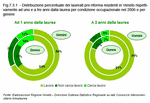 |
| Figure 7.3.2 |
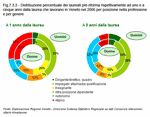 |
| Figure 7.3.3 |
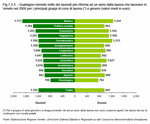 |
| Figure 7.3.4 |
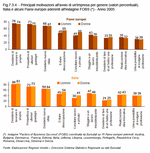 |
| Figure 7.3.5 |
 |
| Figure 7.3.6 |
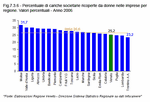 |
| Figure 7.3.7 |
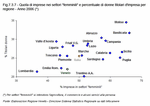 |
| Figure 7.3.8 |
 |
| Figure 7.3.9 |
 |
| Figure 7.3.10 |
 |
| Figure 7.3.11 |
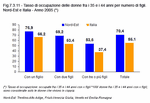 |
| Figure 7.3.12 |
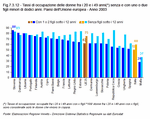 |
| Chapter 7 in figures |
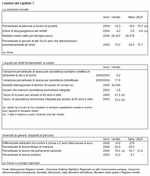 |
|


 Index
Index 












